|
|
Leg Plyometrics
The following is a selection of plyometric exercises designed to develop the lower body's elastic strength.
Bounds (high-intensity)
How to perform the exercise
- Jog into the start of the exercise.
- Push off with your left foot and bring the right leg forward, with
the knee bent, toes dorsiflexed and the thigh parallel to the ground.
- As you push off, reach forward with your left arm.
- The left leg extends back and remains extended for the
duration of the push-off.
- Hold this extended stride for a brief time, then land on your
right foot.
- The left leg then drives through to a forward bent position,
the right arm reaches forward, and the right leg extends backwards.
- Make each stride as long as
possible.
- Land on the sole (flat-footed), allowing
energy to be stored by the elastic components of the leg muscles, and
immediately take off again.
- Try to anticipate the landing and spring up as quickly as you
can.
- Keep the feet touch downtime on the ground for the shortest
time possible.
How much
- One to three sets over 30 to 40 metres.
- Allow a full recovery between each set.
- The quality of bounding is far more critical than quantity.
Hurdle Hopping (medium intensity)
How to perform the exercise
- Jump forward over the barriers with your feet
together.
- The movement should come from your hips and knees.
- Keep your body vertical and straight, and do not let your
knees move apart or to either side.
- Tuck both knees to your chest.
- Use a double-arm swing to maintain balance and gain
height.
- Land on the balls of the feet, allowing energy
to be stored by the elastic components of the leg muscles, and immediately take
off again.
- Try to anticipate the landing and spring up as quickly as you
can.
- Keep the feet touch downtime on the ground to the shortest
time possible.
How much
- One to three sets using 6 to 8 hurdles.
- Allow a full recovery between each set.
- Hurdles should be set up in a row, spaced according to
the athlete's ability.
- The height of the hurdles should be in the region of 12
and 36 inches high.
- The quality of hurdle hopping is far more important than
quantity.
Single-Leg-Hopping (medium intensity)
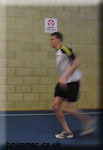 (1) (1) |
 (2) (2) |
 (3) (3) |
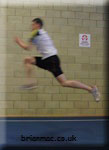 (4) (4) |
| |
|
|
|
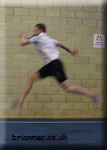 (5) (5) |
 (6) (6) |
 (7) (7) |
 (8) (8) |
How to perform the exercise
- Stand on one leg.
- Push off with the leg you are standing on and jump
forward, landing on the same leg.
- Use a forceful swing of the opposite leg to increase the
length of the jump but aim primarily for height off each jump.
- Land on the ball of the foot, allowing energy
to be stored by the elastic components of the leg muscles, and immediately take
off again.
- Keep the foot touch downtime to the shortest time
possible.
- Try to keep your body vertical and straight.
- Perform this exercise on both legs.
- Beginners will use a straighter leg action, whereas
advanced athletes should try to pull the heel toward the buttocks during the
jump.
- Try to anticipate the landing and spring up as quickly as you
can.
- Keep the feet touch downtime on the ground for the shortest
time possible.
How much
- One to three sets over 30 to 40 metres.
- Allow a full recovery between each set.
- The quality of bounding is far more important than
quantity.
Box Jumps (high-intensity)
 (1) (1) |
 (2) (2) |
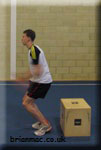 (3) (3) |
 (4) (4) |
| |
|
|
|
 (5) (5) |
 (6) (6) |
 (7) (7) |
 (8) (8) |
How to perform the exercise
- This exercise requires 6 x 40-100cm boxes.
- Assume a deep squat position with your feet shoulder-width
apart at the end of the row of boxes.
- Keep your hands on your hips or behind your head.
- Jump onto the box, landing softly in a squat position on the
balls of the feet.
- Maintaining the squat position, jumping off the box onto the
ground, landing softly in a squat position on the balls of the feet.
- Jump onto the next box and so on.
- Try to anticipate the landing and spring up as quickly as you
can.
- Keep the feet touch downtime on the ground for the shortest
time possible.
How much
- One to three sets using 6 to 8 boxes.
- Allow a full recovery between each set.
- The height of the box should be in the region of 30-80 cm.
- The quality of box jumping is far more important than quantity.
Depth Jumps (high-intensity)
How to perform the exercise
- This exercise requires a 40-100cm box.
- Stand on the box with your toes close to the front edge.
- Step from the box and drop to land on the balls of both
feet.
- Try to anticipate the landing and spring up as quickly as you
can.
- Keep the feet touch downtime on the ground for the shortest
time possible.
How much
- One to three sets using 6 to 8 boxes.
- Allow a full recovery between each set.
- The height of the box should be in the region of 30-80 cm.
- The quality of depth jumping is far more important than
quantity.
Tuck Jumps (low intensity)
How to perform the exercise
- Begin in a standing position.
- Jump up, grabbing both knees as they come up your
chest.
- Return to the starting position landing on the balls of
the feet.
- Try to anticipate the landing and spring up as quickly
as you can.
- Keep the feet touch downtime on the ground for the
shortest time possible.
How much
- 1 to 3 sets.
- Allow a full recovery between each set.
- 5 to 10 repetitions/set.
- The quality of Tuck Jumps is far more important than
quantity.
Two-legged Hops or Bunny Hops (medium intensity)
How to perform the exercise
- Stand with your feet shoulder-width apart.
- Lower into a squat position and jump as far forward as
possible.
- Land on the balls of both feet.
- Try to keep your body vertical and straight, and do not
let your knees move apart or to either side.
- Try to anticipate the landing and spring up as quickly
as you can.
- Keep the feet touch downtime on the ground for the
shortest time possible.
- Use quick double-arm swings and keep landings short.
How much
- 1 to 3 sets.
- Allow a full recovery between each set.
- 5 to 10 repetitions/set.
- The quality of Bunny Hops is far more important than
quantity.
Warm-up
A thorough warm-up is essential before plyometric training. Attention should be on jogging, stretching (static
and ballistic), striding and general mobility, especially on the joints
involved in the planned plyometric session. A warm-down should follow each session.
Where to do it and what to wear
Bounding exercises use surfaces such as grass or resilient
surfaces and
well-cushioned shoes that are stable and can absorb some of the
impacts.
Exercise intensity
| Movement Type |
Example |
Intensity |
| Standing jumps on the spot |
Squat Jumps |
Low |
| Standing jumps |
Standing long jump |
Low-Medium |
| Standing multiple jumps |
5 bounds |
Medium |
| Running multiple jumps |
2 x 10 bounds off 7-stride run-up |
High |
| Depth Jumping |
2 x 6 jumps down/up off 40-100cm boxes |
High |
| Eccentric drop and hold |
5 x Hop and hold |
High |
| Uphill |
Bounding uphill |
Very High |
Young athletes
Moderate jumps can be included in young children (Lohman, 1989). Because of the relatively immature bone structure in pre-adolescents
and adolescents, the high forces exerted during intensive depth
jumps should be avoided (Smith, 1975).
Page Reference
If you quote information from this page in your work, then the reference for this page is:
- MACKENZIE, B. (2000) Leg Plyometrics [WWW] Available from: https://www.brianmac.co.uk/legplymo.htm [Accessed
|
|


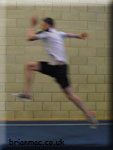
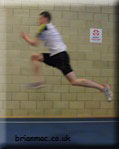
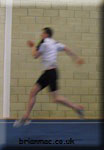

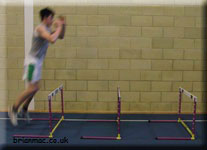
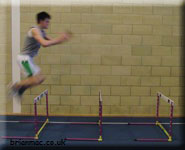
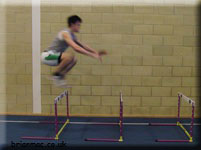
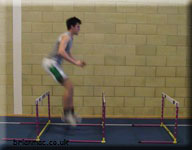
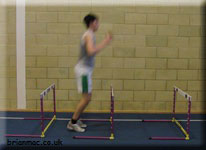
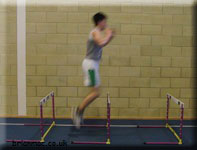
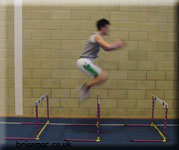
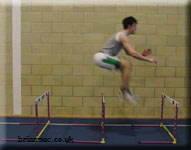
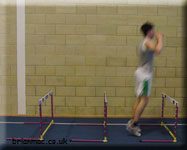
 (1)
(1) (2)
(2) (3)
(3) (4)
(4) (5)
(5) (6)
(6) (7)
(7) (8)
(8) (1)
(1) (2)
(2) (3)
(3) (4)
(4) (5)
(5) (6)
(6) (7)
(7) (8)
(8) (1)
(1) (2)
(2) (3)
(3) (4)
(4)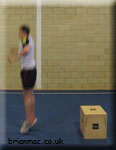 (5)
(5)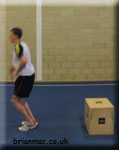 (6)
(6) (1)
(1) (2)
(2) (3)
(3) (4)
(4) (5)
(5) (6)
(6) (1)
(1) (2)
(2) (3)
(3) (4)
(4) (5)
(5) (6)
(6)